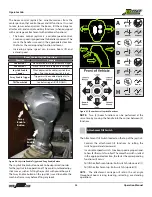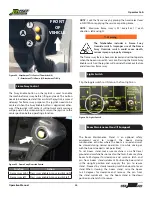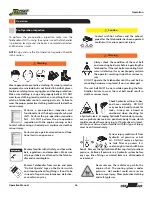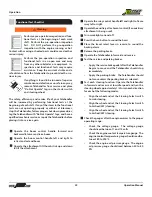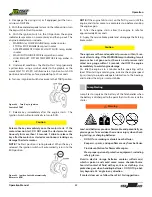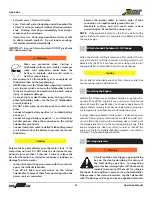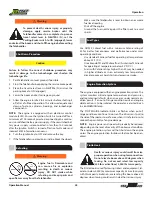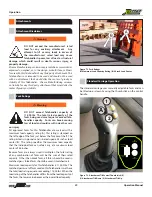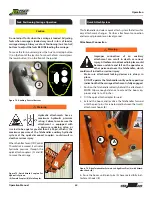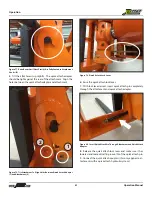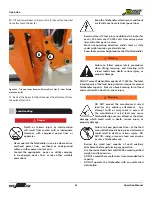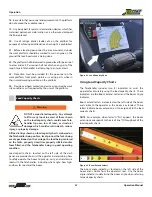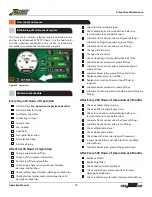
Operation Manual
56
Operation
Caution
DO NOT leave Telehandler unattended during manual
regeneration.
Manual Regeneration
The manual regeneration should be performed by qualified
personnel. This procedure requires the engine to run
continuously for 15 to 30 minutes. The Telehandler cannot be
operated during this procedure.
1. Stop the Telehandler and set the parking brake (Do
not release the parking brake until the regeneration is
complete).
2. Verify the engine is at low idle.
3. Verify the fuel level is sufficient for 30 minutes of operation.
4. Verify the accelerator pedal is not depressed.
5. Press the Manual Regeneration Button.
6. The engine speed will increase to 1000 RPM and the High
Exhaust System Temperature (HEST) indicator will be
displayed.
7. Do not press the accelerator pedal.
8. Allow the manual regeneration to complete without
interruption.
9. Engine speed will decrease to low idle and High Exhaust
System Temperature (HEST) indicator will turn off.
10. The manual regeneration is complete.
11. Turn the engine off and re-start to reset the Exhaust
Aftertreatment System.
Steering Modes
Telehandler Travel
Warning
Never use crab or four wheel (4W) steering for
traveling at high speeds. Use only two wheel
(2W) steering for higher speed travel and slow
the Telehandler before turning. Rapid turning
using crab, four wheel (4W), or the optional
two wheel rear (2WR) steering could cause tip over, which
could result in death, serious injury, or property damage.
Check the turning radius around the Telehandler before
making a turn, especially if using four wheel (4W) steering
or two wheel rear (2WR) steering, which provide a tighter
turning radius. Look over your shoulder in the direction
of the turn when backing. Failure to remain aware of your
Caution
DO NOT change steering modes until Telehandler slows or
comes to a complete stop. Align all four (4) wheels “straight-
ahead”, or perpendicular to the axle, before changing
steering mode. Changing steering modes without aligning
all four (4) wheels may result in equipment damage.
The Telehandler includes three STANDARD modes of steering;
Crab, Two Wheel (2W), and Four Wheel (4W) Steering. Use the
Steering Select switch located on the dash panel to change
steering modes.
turning radius area could result in death, serious injury, or
equipment damage.
Crab steering allows all four (4) wheels to turn
in the same direction as the steering wheel,
allowing the Telehandler to move “sideways”.
Crab steering is useful in a congested work site
to line up to a loading location.
Crab Steering
Two wheel (2W) steering allows the front
wheels to turn in the same direction as the
steering wheel. The rear wheels remain in
a fixed forward position. Two wheel (2W)
steering is useful for traveling at higher speeds.
Two Wheel Front Steering (2W)
Four wheel (4W) steering allows the front
wheels to turn in the same direction and the
rear wheels to turn in the opposite direction
of the steering wheel. The rear wheels follow
the front wheel path. Four wheel (4W) steering
is useful for a short turning radius and in muddy or sandy
conditions.
Four Wheel Steering (4W)
Two Wheel Rear Steering (2WR) - OPTIONAL
OPTIONAL two wheel rear (2WR) steering allows
the rear wheels to turn in the same direction as
the steering wheel. The front wheels remain in a
fixed forward position.
NOTE: A separate switch is located on the right side of the
dash panel to engage and disengage the optional two wheel
rear (2WR) steering mode.
The Telehandler includes three STANDARD modes of steering;
Crab, Two Wheel (2W), and Four Wheel (4W) Steering. Use the
Steering Select switch located on the dash panel to change
steering modes.


